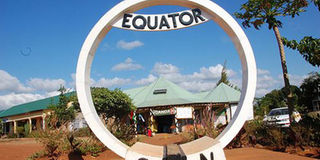Equator: profitably combining nature’s gifts with tourism

The next time you visit the Equator, be sure to take a photograph because it is more beautiful and inviting, thanks to the Embassy of Ireland. During the St Patrick Day, the embassy, like is tradition, enhanced a feature around the world, and that is how the Equator got a facelift.
Many nature lovers have appreciated the gesture because the Equator is such a unique feature. Nature Uganda’s Achilles Byaruhanga applauds the Embassy of Ireland for partnering with Uganda Tourism Board (UTB), in beautifying the equator.
UTB’s public relations and marketing manager, Edwin Muzahura, confirms the developments and says the embassy, as part of celebrations of St Patrick Day, painted the equator green.
How much do you know about the equator?
This is a question little boy Raymond Kamya always put to his father every time they approached the Equator sign on Masaka highway.
He always saw people making a stop to take photos at the physical feature. His father did not have much explanation about it save for the obvious North and South poles marked on it by the denoting letters.
Kamya’s teacher has spoken about the equator in Social Sciences (SST) class and he was excited to explain to his father, starting with the definition.
“The equator can be defined as the great circle of the earth that is equally distant from the North Pole and South Pole,” he explained, attracting a smile from his father.
Location
In Uganda, the Equator is located in Kayabwe, in Masaka. Over the years, both local and foreign tourists have grown interest in the Equator.
Business-minded Ugandans have seen the opportunity in the big numbers making a stop at this point and have set up eateries and craft shops.
Tourists can have a bite and drink and proceed to buy memorabilia from the shops. Some of the entrepreneurs there are creative and sell artistic merchandise out of local materials such as backcloth, cowrie shells or well-woven mats and other decorative items.
There are books sold, with literature about the Equator and Uganda attractions and facts at large. So beyond the cyclic feature, there is much to be learnt and acquired, for keeps.
From the literature, you will be able to learn that the Equator passes through 13 countries: Ecuador, Colombia, Brazil, Sao Tome & Principe, Gabon, Republic of the Congo, Democratic Republic of the Congo, Kenya, Somalia, Maldives, Indonesia Kiribati and Uganda.
Relevance
Uganda Tourism Association of Uganda (UTA)’s Herbert Byaruhanga notes that not many countries are blessed with the equator crossing through them.
Tours and travel agents and enterpreneurs are glad to share more information, particularly about the unique aspects of the equator.
Edris Kisambira is managing director at Africa Uzuri Safaris, and explains that the Equator is very significant on Uganda’s tourism circuit to south western Uganda.
“It is a must-stop for visitors as it adds to their safari memories. Tourists take photos which become memories for their Ugandan safari. The equator offers travellers a chance to say they had one leg or an arm in the southern hemisphere while the other was in the north,” Kisambira observes.
He adds that tourists are always curious and glad to learn about the equator, something Simon Tebyasa, director of Harmony Safaris Limited, confirms, adding that the feature is part of the itinerary since it is a good stop for weary travellers especially on the return journeys from placessuch as Bwindi Impenetrable and Queen Elizabeth national parks for a quick refreshment.
“By the way it has a unique attraction where visitors get to see the magnetism that exists when the northern and southern hemisphere meet - essentially guides at the place put a flower or an item in a bowl of water and then place it at the exact line - the result is that item will swirl with the power/magnetism that exists where the two hemispheres meet,” Kisambira points out.
Magical powers
Achilles Byaruhanga observes that the Equator’s strong magnetic field can attract metallic objects. “What’s more is the fact that the Equator is located in a rich biodiversity, given that Uganda is ranked one of the 10 most bio-diverse countries in the world,” the conservationist adds.
“As lines of latitude increase in size, a point has to travel faster to complete a circle (revolution) in the same amount of time. The rotational speed, or spin, at the Arctic Circle is slower than the spin at the Tropic of Cancer, because the circumference of the Arctic Circle is much smaller and a point doesn’t have to travel as far to complete a revolution,” National Geographic Society (NGS), one of the largest non-profit scientific and educational institutions in the world, cites.
“The weather is consistently hot and wet– call it tropical– so if one enjoys that climate it would be highly beneficial to live on the Equator although the direct sun may come as a disadvantage. In addition to the tropical weather, Uganda is one of the cheapest place to retire to in Africa,” Tebyasa concludes.
THE BACKGROUND
The spin at the Tropic of Cancer is much slower than the spin at the Equator. Near the poles, the Earth’s rotational speed, or spin, is near zero. At the Equator, the spin is about 1,670 kilometres per hour (1,038 miles per hour).
Achilles Byaruhanga says Uganda needs to take more advantage of the Equator. Simon Tebyasa explains that there are a number of significant aspects brought by the geographical location of the Equator, one very pronounced advantage being good weather conditions in equatorial regions.




